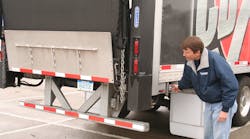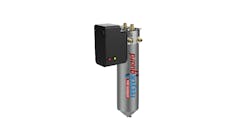There are many different styles of liftgates, but all are meant to improve truck loading and unloading, especially when the shipping or receiving location does not have a loading dock and manual loading and unloading is necessary. Liftgates can increase delivery speed, particularly with heavy cargo. This can help minimize product damage since cargo delivered with the help of a liftgate is less subject to damage from dropping or mishandling. Additionally, liftgates enhance workplace safety related to personal back and lifting injuries.
For a liftgate to provide the lowest cost of operation, it has to be spec’d correctly. Having the appropriate type of liftgate for the intended application is essential to the lifgate’s performance and safe operation.
Then, the liftgate must be well-maintained. Regular maintenance is a necessity to keep a liftgate working properly and functioning to its maximum capacity. Keeping a liftgate in good operating condition also decreases the risk for malfunction, helping prevent worker injuries, loss of time and loss of products.
SPEC’ING CONCERNS
One of the foremost considerations in determining the appropriate liftgate is how much weight and square footage is transferred on a daily basis on the vehicle, says Neal Nieberding of Leyman Liftgates, a Cincinnati, OH-based designer and manufacturer of liftgates. This information is needed to determine the liftgate’s platform size - length by width - and hauling capacity.
“Overloading a liftgate serves as a potential safety hazard and could affect its performance over a long period of time,” he notes.
Other important spec’ing considerations are vehicle size, overall body width, type of doors - overhead (rollup) or swinging - and where the liftgate will be mounted, says Nieberding.
Not to be overlooked is whether a load retention system is needed for bulky, wheeled or hard-to-handle cargo; what material handling devices will be used while loading/unloading; and if there are any dock loading/unloading requirements.
It is also advisable to look at how often the liftgate is going to be used in a given day and how much power will be required by the liftgate’s batteries.
A “heavy” liftgate user typically uses a liftgate more than 50 times per day, he says. To supply enough power for a heavy user, more batteries may be required to fulfill a full day’s work without interruptions. Making sure the liftgate’s wire sizes from the motor to the batteries are adequate could help contribute to maintain optimal power supply.
As a liftgate is used, its overall appearance and ability to function will slowly deteriorate over a period of time due to normal wear and tear, says Nieberding. Operating in colder climate conditions can cause increased wear and tear on a liftgate, such as loss in battery power and decreased performance of the hydraulics.
To resolve these issues, additional batteries may be required, he says, and suggests using specialized hydraulic fluids designed especially for use where low temperatures or rapid changes in temperatures are expected.
Rust is also a major issue for liftgates, Nierberding says. Depending on operating conditions, consider additional corrosion and rust inhibitor exterior coatings.
UNIVERSAL MATTERS
When it comes to liftgate maintenance, because there are numerous styles of lifts, not to mention various brands, details will inevitably vary, says Lowell Boe, a lead engineer at Tommy Gate Company, a manufacturer of hydraulic liftgates based in Woodbine, IA. “It is important to familiarize oneself as completely as possible with the specific products that comprise any fleet. However, there are a few universal points that should be followed no matter which product a fleet is using.”
1. Sufficiently train staff on proper operational procedures. Boe says everyone who operates liftgates must understand and strictly adhere to the manufacturer’s suggested usage for liftgates. “Most major products on the market have undergone stringent testing and are generally capable of completing thousands of cycles without fail. Following suggested usage maximizes the longevity and efficiency of any liftgate. The majority of problems occur when operators are not using the machinery in the way that it is intended.”
2. Get acquainted with the product’s parts. Reputable liftgate manufacturers offer easy access, often through websites and/or downloadable PDFs, to complete parts posters and lists of all available products. Although it isn’t necessary to memorize the placement of every nut and bolt, he says a general understanding of how a fleet’s equipment is constructed makes it possible to identify wear and assess potential problems through simple, routine inspections.
Examples of wear items are chains, cables, bearings, sliding pads, etc.
3. Maintain oil levels in hydraulic pumps. The most important part of any hydraulic system is the hydraulic pump, and by extension, the hydraulic fluid which is transferred through that pump, explains Boe. “Hydraulic fluid in a hydraulic system is responsible for transference of power, arguably the most critical aspect of a hydraulic liftgate.”
By maintaining the proper fluid level in the hydraulic reservoir, consistent function of the machine is ensured, he says. Consult the owner’s manual of the particular liftgate for the recommended hydraulic fluid type and grade, and the recommended inspection cycles. When appropriate, check the fluid level of each liftgate in the fleet.
4. Lubricate designated points as directed. Much like a bicycle chain, any hydraulic liftgate consists of parts which require cleaning and lubrication on a recommended schedule. Proper lubrication minimizes minor issues with liftgate operations, as well as ensures safety for the operator.
“Be sure to clean the designated piece, as well as surrounding areas, before applying the approved lubricants,” says Boe. “Although recommended schedules should be adhered to, for liftgates which are exposed to severe weather on a continual basis, it would be wise to inspect them more often.”
5. Minimize rust. Rust is an unavoidable reality with hydraulic liftgates. Not only does rust on a liftgate have the potential to degrade the overall appearance of a liftgate, it could, over time, create problems in its function.
Regional differences will result in varying severity of rust issues, but rust damage should be taken seriously, Boe says. “The easiest way to fight rust is to keep the liftgate clean. Be sure to wash off road salt and grime, and rinse any chemical spillage off immediately.
“An owner’s manual for the specific product being used is an invaluable reference. If one isn’t on file, contact the manufacturer and request one.”
SERVICING POINTS
Jeff Peterson of SAF-Holland, Muskegon, MI, a company that specializes in coupling, lifting and suspension systems for trucks, buses, tractors and trailers, offers the following recommendations on liftgate maintenance:
1. The loading platform should be lowered to the ground, or must be properly supported when in the raised position. “While working on a liftgate, it is always best to have the lifting platform in its full open position and resting on the ground,” he says. “This practice will prevent the possibility of any unintentional lowering of the platform which could put the service personnel in a dangerous situation.”
When it is not possible to have the liftgate platform on the ground, the liftgate platform and mechanism should be adequately secured in the stored position using chains, overhead lifting devices or some other means to assure the safety of the service personnel, he advises. “Never rely exclusively on the storage latches or hydraulic systems to secure the lifting mechanism during repair or routine maintenance. In addition, never work under the liftgate platform while it is in the raised position.”
2. Service technicians need to be aware of platform and lift-arm pinch points. Many liftgate designs have multiple arms that are in motion during the liftgate platform’s raising/lowering/opening/losing operations, notes Peterson. “Service technicians should familiarize themselves with the operation of the liftgate prior to maintenance and repair to avoid injury from potential pinch points on and around the liftgate.”
3. Service technicians need to be aware that hydraulic fluid is under pressure and the dangers associated with it. Because hydraulic systems can build up pressures as high as 3,000 psi, service technicians should take precautions when working around high-pressure hydraulic lines to avoid injury from these high pressures, Peterson says. Protective clothing, such as gloves and safety glasses, should always be worn.
“When loosening hydraulic fittings, a good practice is to rotate the fitting in 1/8 turn increments until fluid is just beginning to drip, and then allow the pressure to be relieved before continuing the 1/8 turn procedure,” he advises. “When reconnecting fittings, it is a good practice to stay back from the work area as the hydraulic system is re-energized until technicians are sure the fittings are properly secured and not leaking.”
Caution should also be taken when working with drills, grinders, torches, etc., in and around hydraulic lines due to the high pressures and potential flash points of some hydraulic fluids.
4. Disconnect ground strap on batteries. Whenever working on liftgates - regardless of whether it’s an electrical, mechanical or hydraulic repair, it is a good practice to disconnect the ground strap on the batteries to cut power to the electrical system, says Peterson. “Do not rely on the shut off switch inside the cab of the vehicle or in the pump box. In many cases, these only turn off power to the switches, not the power to the pump and motor.
“Failure to disconnect power to the system can result in accidental activation of the liftgate, electrical burns or damage to electrical components on the liftgate.”
5. Activate vehicle four-way lights and place reflectors before working on a disabled vehicle on the roadside. Roadside repairs pose their own set of hazards due to the fact that there are moving vehicles in the area, he says. The best practice is to secure the liftgate in an up-and-stored position, and move the vehicle off the side of the road to an area where the repairs can be made in a safe environment.
When this is not possible, all precautions should be taken, such as activating the four-way flashers and marker lights on the vehicle, and placing flares or reflective cones around the vehicle to warn oncoming traffic. When using flares, keep them far enough away from the vehicle to avoid the potential ignition of any fluids that may have leaked from the vehicle.
Avoid the rear and roadside of the vehicle as much as possible and work only on the non-roadside of the vehicle, he adds. Service technicians should wear reflective clothing to give oncoming traffic as much warning as possible of their presence.
6. Thoroughly read and understand the liftgate manufactures owner’s manual and guides. Liftgate manufactures typically provide owner’s manuals which contain important information on operation, maintenance and safety when using and maintaining their products.
These documents should be kept on file at the fleet’s maintenance facilities and in any service vehicles that will be used to make service calls, Peterson says. It is also a good practice to place a copy inside the cab of the truck for reference when needed.
SEEK HELP
Don’t be hesitant about contacting liftgate manufacturers and their local distributors for assistance in maintaining and servicing your fleet’s liftgates, or with questions about warranty, concur SAF-Holland’s Peterson, Leyman Liftgates’ Neiberding and Tommy Gate’s Boe.
“Most customer service departments are eager to be as helpful as possible,” Boe says.
“Many liftgate manufacturers are able to provide training on routine maintenance, diagnostics, repair and safety precautions to use when working on their products,” adds Peterson. “In addition, most liftgate manufacturers offer owner’s manuals, maintenance guides and technical bulletins online that provide valuable service and safety information.”




